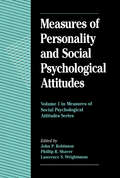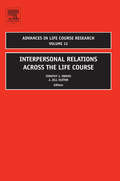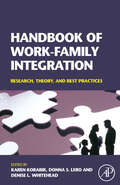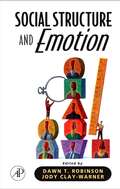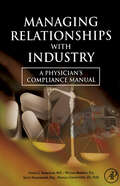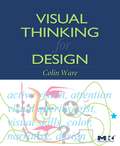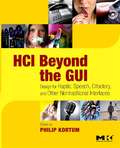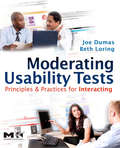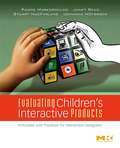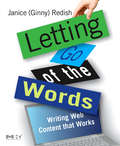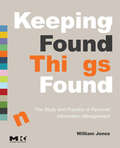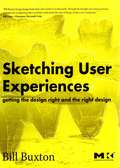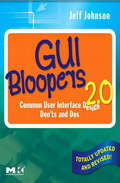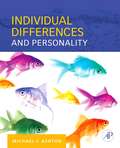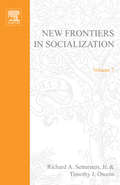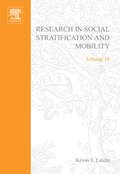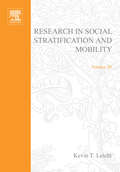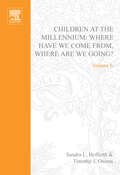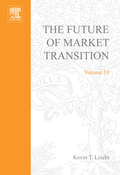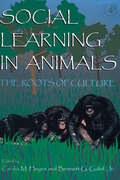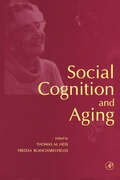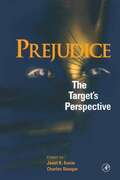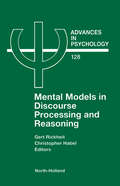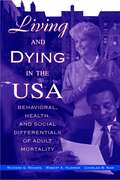- Table View
- List View
Measures of Personality and Social Psychological Attitudes (Measures of Social Psychological Attitudes #Volume 1)
by Phillip R. Shaver Lawrence S. WrightsmanThis volume is sponsored by Division 9 of the American Psychological Association: The Society for the Psychological Study of Social Issues.****This is an essential reference book for any social scientist or student who uses measuresof attitude or personality in his or her research. The earlier version, published twenty years ago, was to be found on the shelf of virtually everyone who worked in the field.Serves as an update and extension of a highly useful book published twenty years agoEmploys a systematic standardized evaluation of 150 scalesChapters on specific types of scales are written by experts in those subfields
Interpersonal Relations Across the Life Course (ISSN #Volume 12)
by Timothy J. Owens J. Jill SuitorThis volume (number 12) is subtitled Interpersonal Relations across the Life Course. It is inspired by the increased awareness in recent years of the way in which structural and psychosocial dimensions of the life course shape interpersonal relations. Interest in this issue has included both the maintenance of long-term relationships that may span many phases of the life course and the development of relationships that are specific to particular phases. The volume is a combination of invited and author initiated papers--all anonymously peer reviewed--that seeks to present a cohesive source of information on the multiform nature and influences of interpersonal relations from a variety of perspectives, theoretical frames, and substantive areas. Contributions reflect:Macro-micro linkages and interpersonal relations, (i.e., age structures, social institutions, and race/ethnicity) Parenting across the life course Parent-adult child relations and transitionsTransitions in non-kin relationshipsSocial relationships and well-being
Handbook of Work-Family Integration: Research, Theory, and Best Practices
by Karen Korabik Donna S. Lero Denise L. WhiteheadIn today's industrialized societies, the majority of parents work full time while caring for and raising their children and managing household upkeep, trying to keep a precarious balance of fulfilling multiple roles as parent, worker, friend, & child. Increasingly demands of the workplace such as early or late hours, travel, commute, relocation, etc. conflict with the needs of being a parent. At the same time, it is through work that people increasingly define their identity and self-worth, and which provides the opportunity for personal growth, interaction with friends and colleagues, and which provides the income and benefits on which the family subsists. The interface between work and family is an area of increasing research, in terms of understanding stress, job burn out, self-esteem, gender roles, parenting behaviors, and how each facet affects the others. The research in this area has been widely scattered in journals in psychology, family studies, business, sociology, health, and economics, and presented in diverse conferences (e.g., APA, SIOP, Academy of Management). It is difficult for experts in the field to keep up with everything they need to know, with the information dispersed. This Handbook will fill this gap by synthesizing theory, research, policy, and workplace practice/organizational policy issues in one place. The book will be useful as a reference for researchers in the area, as a guide to practitioners and policy makers, and as a resource for teaching in both undergraduate and graduate courses.
Social Structure and Emotion
by Jody Clay-Warner Dawn T. RobinsonAs a reference that contains original and innovative research on the sociology of emotion, this book will not only appeal to sociologists but also to scholars of psychology, psychiatry, anthropology, history, social work, and business/management. With contributions from experts in the field, this text examines the role and influence of emotion in everyday social circumstances. It poses clear questions and presents the contemporary theoretical developments and empirical research linking social structure and emotion.Comparable books are narrowly focused and less comprehensive, the breadth and depth of this new work is unmatched.*Explores the roles played by emotion in social arrangements (i.e., the power of emotions in psychology, finance, economics, etc...)*Poses clear questions and presents the newest theoretical developments and empirical research linking social structure and emotion*Contributions from experts in the field
Managing Relationships with Industry: A Physician's Compliance Manual
by Steven C. Schachter William Mandell Scott Harshbarger Randall GrometsteinNow more than ever, doctors are being targeted by government prosecutors and whistleblowers challenging the legality of their relationships with drug and device companies. With reputations at stake and the risk of civil and criminal liability, it is incumbent upon doctors to protect themselves. Managing Relationships with Industry: A Physician’s Compliance Manual is an indispensable resource for doctors, professional societies, academic medical centers, community hospitals, and group practices struggling to understand the ever changing law and ethical standards on interactions with pharmaceutical and device companies. It is the first comprehensive summary of the law and ethics on physician relationships with industry written for the physician. Authored by a former state Attorney General, Harvard Medical School Professor, health care lawyer and professor of ethics, Managing Relationships approaches the topic from a balanced and reasoned perspective adding to the on-going national dialogue and debate on the proper limits to medicine’s relationship with industry.The first complete and up-to-date summary and analysis of the law and ethics on physician-industry relationshipsFocuses on major enforcement actions and whistleblower lawsuits and the lessons learned for physiciansProvides options and guidance for maintaining compliant relationships and avoiding traps for the unwaryCovers both drug and device company relationshipsSummarizes the types of industry relationships that are necessary and productive and those that are harmful and abusiveDetails the law and ethics for each type of relationship including gifts, off-label uses and marketing, CME, speaker’s bureaus, free samples, grants, consulting arrangements, etc.Includes sample contracts for permissible consulting and CME speaker engagements
Visual Thinking for Design
by Colin WareVisual Thinking brings the science of perception to the art of design. Designers increasingly need to present information in ways that aid their audience’s thinking process. Fortunately, results from the relatively new science of human visual perception provide valuable guidance. In this book, Colin Ware takes what we now know about perception, cognition, and attention and transforms it into concrete advice that designers can directly apply. He demonstrates how designs can be considered as tools for cognition – extensions of the viewer’s brain in much the same way that a hammer is an extension of the user’s hand. The book includes hundreds of examples, many in the form of integrated text and full-color diagrams. Experienced professional designers and students alike will learn how to maximize the power of the information tools they design for the people who use them.Presents visual thinking as a complex process that can be supported in every stage using specific design techniquesProvides practical, task-oriented information for designers and software developers charged with design responsibilitiesIncludes hundreds of examples, many in the form of integrated text and full-color diagramsSteeped in the principles of “active vision," which views graphic designs as cognitive tools
HCI Beyond the GUI: Design for Haptic, Speech, Olfactory, and Other Nontraditional Interfaces (Interactive Technologies)
by Philip KortumAs technology expands and evolves, one-dimensional, graphical user interface (GUI) design becomes increasingly limiting and simplistic. Designers must meet the challenge of developing new and creative interfaces that adapt to meet human needs and technological trends. HCI Beyond the GUI provides designers with this know how by exploring new ways to reach users that involve all of the human senses. Dr. Kortum gathers contributions from leading human factors designers to present a single reference for professionals, researchers, and students.Explores the human factors involved in the design and implementation of the nontraditional interfaces, detailing design strategies, testing methodologies, and implementation techniquesProvides an invaluable resource for practitioners who design interfaces for children, gamers and users with accessibility needsOffers extensive case studies, examples and design guidelines
Moderating Usability Tests: Principles and Practices for Interacting (Interactive Technologies)
by Joseph S. Dumas Beth A. LoringModerating Usability Tests provides insight and guidance for usability testing. To a large extent, successful usability testing depends on the skills of the person facilitating the test. However, most usability specialists still learn how to conduct tests through an apprentice system with little formal training. This book is the resource for new and experienced moderators to learn about the rules and practices for interacting. Authors Dumas and Loring draw on their combined 40 years of usability testing experience to develop and present the most effective principles and practices – both practical and ethical – for moderating successful usability tests. The videos are available from the publisher's companion web site.Presents the ten “golden rules" that maximize every session’s valueOffers targeted advice on how to maintain objectivityDiscusses the ethical considerations that apply in all usability testingExplains how to reduce the stress that participants often feelConsiders the special requirements of remote usability testingDemonstrates good and bad moderating techniques with laboratory videos accessible from the publisher’s companion web site
Evaluating Children's Interactive Products: Principles and Practices for Interaction Designers (Interactive Technologies)
by Panos Markopoulos Janet C Read Stuart MacFarlane Johanna HoysniemiEvaluating Children's Interactive Products directly addresses the need to ensure that interactive products designed for children — whether toys, games, educational products, or websites — are safe, effective, and entertaining. It presents an essential background in child development and child psychology, particularly as they relate to technology; captures best practices for observing and surveying children, training evaluators, and capturing the child user experience using audio and visual technology; and examines ethical and legal issues involved in working with children and offers guidelines for effective risk management. Based on the authors' workshops, conference courses, and own design experience and research, this highly practical book reads like a handbook, while being thoroughly grounded in the latest research. Throughout, the authors illustrate techniques and principles with numerous mini case studies and highlight practical information in tips and exercises and conclude with three in-depth case studies. This book is recommended for usability experts, product developers, and researchers in the field.* Presents an essential background in child development and child psychology, particularly as they relate to technology. * Captures best practices for observing and surveying children, training evaluators, and capturing the child user experience using audio and visual technology.* Examines ethical and legal issues involved in working with children and offers guidelines for effective risk management.
Letting Go of the Words: Writing Web Content that Works (Interactive Technologies)
by Janice (Ginny) Redish"Redish has done her homework and created a thorough overview of the issues in writing for the Web. Ironically, I must recommend that you read her every word so that you can find out why your customers won't read very many words on your website -- and what to do about it."-- Jakob Nielsen, Principal, Nielsen Norman Group“There are at least twelve billion web pages out there. Twelve billion voices talking, but saying mostly nothing. If just 1% of those pages followed Ginny’s practical, clear advice, the world would be a better place. Fortunately, you can follow her advice for 100% of your own site’s pages, so pick up a copy of Letting Go of the Words and start communicating effectively today."--Lou Rosenfeld, co-author, Information Architecture for the World Wide WebOn the web, whether on the job or at home, we usually want to grab information and use it quickly. We go to the web to get answers to questions or to complete tasks – to gather information, reading only what we need. We are all too busy to read much on the web.This book helps you write successfully for web users. It offers strategy, process, and tactics for creating or revising content for the web. It helps you plan, organize, write, design, and test web content that will make web users come back again and again to your site. Learn how to create usable and useful content for the web from the master − Ginny Redish. Ginny has taught and mentored hundreds of writers, information designers, and content owners in the principles and secrets of creating web information that is easy to scan, easy to read, and easy to use. This practical, informative book will help anyone creating web content do it better.Features* Clearly-explained guidelines with full color illustrations and examples from actual web sites throughout the book. * Written in easy-to-read style with many "befores" and "afters."* Specific guidelines for web-based press releases, legal notices, and other documents.* Tips on making web content accessible for people with special needs.Janice (Ginny) Redish has been helping clients and colleagues communicate clearly for more than 20 years. For the past ten years, her focus has been helping people create usable and useful web sites. She is co-author of two classic books on usability: A Practical Guide to Usability Testing (with Joseph Dumas), and User and Task Analysis for Interface Design (with JoAnn Hackos), and is the recipient of many awards.* Clearly-explained guidelines with full color illustrations and examples from actual web sites throughout the book.* Written in easy-to-read style with many "befores" and "afters."* Specific guidelines for web-based press releases, legal notices, and other documents. * Tips on making web content accessible for people with special needs.
Keeping Found Things Found: The Study and Practice of Personal Information Management (Interactive Technologies)
by William JonesKeeping Found Things Found: The Study and Practice of Personal Information Management is the first comprehensive book on new 'favorite child' of R&D at Microsoft and elsewhere, personal information management (PIM). It provides a comprehensive overview of PIM as both a study and a practice of the activities people do, and need to be doing, so that information can work for them in their daily lives. It explores what good and better PIM looks like, and how to measure improvements. It presents key questions to consider when evaluating any new PIM informational tools or systems. This book is designed for R&D professionals in HCI, data mining and data management, information retrieval, and related areas, plus developers of tools and software that include PIM solutions.Focuses exclusively on one of the most interesting and challenging problems in today's worldExplores what good and better PIM looks like, and how to measure improvementsPresents key questions to consider when evaluating any new PIM informational tools or systems
Sketching User Experiences: Getting the Design Right and the Right Design (Interactive Technologies)
by Bill BuxtonSketching User Experiences approaches design and design thinking as something distinct that needs to be better understood—by both designers and the people with whom they need to work— in order to achieve success with new products and systems. So while the focus is on design, the approach is holistic. Hence, the book speaks to designers, usability specialists, the HCI community, product managers, and business executives. There is an emphasis on balancing the back-end concern with usability and engineering excellence (getting the design right) with an up-front investment in sketching and ideation (getting the right design). Overall, the objective is to build the notion of informed design: molding emerging technology into a form that serves our society and reflects its values. Grounded in both practice and scientific research, Bill Buxton’s engaging work aims to spark the imagination while encouraging the use of new techniques, breathing new life into user experience design.Covers sketching and early prototyping design methods suitable for dynamic product capabilities: cell phones that communicate with each other and other embedded systems, "smart" appliances, and things you only imagine in your dreamsThorough coverage of the design sketching method which helps easily build experience prototypes—without the effort of engineering prototypes which are difficult to abandonReaches out to a range of designers, including user interface designers, industrial designers, software engineers, usability engineers, product managers, and othersFull of case studies, examples, exercises, and projects, and access to video clips that demonstrate the principles and methods
GUI Bloopers 2.0: Common User Interface Design Don'ts and Dos (Interactive Technologies)
by Jeff JohnsonGUI Bloopers 2.0, Second Edition, is the completely updated and revised version of GUI Bloopers. It looks at user interface design bloopers from commercial software, Web sites, Web applications, and information appliances, explaining how intelligent, well-intentioned professionals make these mistakes – and how you can avoid them. GUI expert Jeff Johnson presents the reality of interface design in an entertaining, anecdotal, and instructive way while equipping readers with the minimum of theory. This updated version reflects the bloopers that are common today, incorporating many comments and suggestions from first edition readers. It covers bloopers in a wide range of categories including GUI controls, graphic design and layout, text messages, interaction strategies, Web site design – including search, link, and navigation, responsiveness issues, and management decision-making. Organized and formatted so information needed is quickly found, the new edition features call-outs for the examples and informative captions to enhance quick knowledge building. This book is recommended for software engineers, web designers, web application developers, and interaction designers working on all kinds of products.Updated to reflect the bloopers that are common today, incorporating many comments and suggestions from first edition readersTakes a learn-by-example approach that teaches how to avoid common errorsCovers bloopers in a wide range of categories: GUI controls, graphic design and layout, text messages, interaction strategies, Web site design -- including search, link, and navigation, responsiveness issues, and management decision-makingOrganized and formatted so information needed is quickly found, the new edition features call-outs for the examples and informative captions to enhance quick knowledge buildingHundreds of illustrations: both the DOs and the DON'Ts for each topic covered, with checklists and additional bloopers on www.gui-bloopers.com
Individual Differences and Personality
by Michael C. AshtonDesigned for upper level undergraduate and graduate level students inquiring about the psychology of personality and individual differences, this textbook focuses on the personality traits and related characteristics that make each person unique. Basic principles of personality measurement are explained and crucial scientific questions of personality psychology are examined via a reader-friendly style and various boxes of interesting asides to keep students’ attention.Unlike lower-level texts written from a historical perspective that concentrate solely on theory, this textbook summarizes and integrates the contemporary research available about individual differences.Emphasizes current research
New Frontiers in Socialization (ISSN #Volume 7)
by Richard A. Settersten Jr. Timothy J. OwensNew Frontiers in Socialization
Research in Social Stratification and Mobility (ISSN #Volume 18)
by Kevin T. LeichtThis text reflects the growing diversity of perspectives, methods and insights currently used in social stratification research. Authors discuss the following broad themes from an international perspective: the changing real and symbolic boundaries of social stratification; who benefits from rapidly changing markets; immigration, marginalization and exclusion; and modelling occupational mobility. The contributions demonstrate the changing nature of social stratification systems in today's global and fragmented economy.
Research in Social Stratification and Mobility (ISSN #Volume 20)
by Kevin T. LeichtVolume 20 of "Research in Social Stratification and Mobility" continues to remain at the forefront of the diverse group of social scientists who study social inequality and is now the official publication of the Social Stratification Research Group of the International Sociological Association (RC-28). This issue features a comprehensive retrospective on the 40 years of contributions to social stratification research made by the late William Sewell and the Wisconsin Longitudinal Survey, including an all-inclusive bibliography of publications. Other contributions address the growing differences between workers with full-time jobs and various categories of the underemployed (in Israel, the United States and Germany), social mobility in Korea and Sweden, subjective responses to social inequality and the social consequences of status inconsistency, and analyses of class consciousness and growing wealth inequality in the OECD.
Children at the Millennium: Where Have We Come From? Where Are We Going? (ISSN #Volume 6)
by Timothy J. Owens Sandra L. HofferthChildren at the Millennium
Changing Life Patterns in Western Industrial Societies (ISSN #Volume 8)
by Janet Zollinger Giele Elke HolstChanging Life Patterns in Western Industrial Societies
The Future of Market Transition (ISSN #Volume 19)
by Kevin T. LeichtThe collapse of the state-controlled economies of the former Eastern Bloc will certainly change the way the global economy operates. Bringing together scholars from a wide variety of theoretical perspectives, different nations and different empirical research traditions, this title examines the ongoing transition and the implications of market transitions for individual life chances, state economic policy and social stratification systems. The volume includes scholarship that focuses on both single nation and cross-national research, plus research contributions that compare state socialist/former state socialist political economies with conditions elsewhere in the world.
Social Learning In Animals: The Roots of Culture
by Bennett G. Galef Jr. Cecilia M. HeyesThe increasing realization among behaviorists and psychologists is that many animals learn by observation as members of social systems. Such settings contribute to the formation of culture. This book combines the knowledge of two groups of scientists with different backgrounds to establish a working consensus for future research. The book is divided into two major sections, with contributions by a well-known, international, and interdisciplinary team which integrates these growing areas of inquiry.Integrates the broad range of scientific approaches being used in the studies of social learning and imitation, and society and cultureProvides an introduction to this field of study as well as a starting point for the more experienced researcherChapters are succinct reviews of innovative discoveries and progress made during the past decadeIncludes statements of varied theoretical perspectives on controversial topicsAuthoritative contributions by an international team of leading researchers
Social Cognition and Aging
by Thomas M. Hess Fredda Blanchard-FieldsMost of the research done in social cognition has been conducted with younger adults and may not be applicable to a much older population. Social Cognition and Aging provides a snapshot view of research that has been done with older adults or is directly applicable to this population. Focusing on issues of self identity, social interactions, and social perceptions, this book provides a broad overview of how aging affects one's own perceptions and actions as well as how others perceive and interact with the aged. Coverage includes such topics as self-control, memory, resilience, age stereotypes, moral development, and the "art" of living. With contributions from top researchers in both gerontology and psychology, this book is an important reference for academics and professionals alike in personality, cognition, social psychology, adult development, sociology, and gerontology.
Prejudice: The Target's Perspective
by Janet K. Swim Charles StangorPrejudice: The Target's Perspective turns the tables on the way prejudice has been looked at in the past. Almost all of the current information on prejudice focuses on the person holding prejudiced beliefs. This book, however, provides the first summary of research focusing on the intended victims of prejudice. Divided into three sections, the first part discusses how people identify prejudice, what types of prejudice they encounter, and how people react to this prejudice in interpersonal and intergroup settings. The second section discusses the effect of prejudice on task performance, assessment of ones own abilities, self-esteem, and stress. The final section examines how people cope with prejudice, including a discussion of coping mechanisms, reporting sexual harassment, and how identity is related to effective coping.Includes an introduction, the consequences of prejudice, and how to cope with prejudiceThe editors are top researchers in the field of prejudiceAll the contributors are major figures in the social psychological analysis of intergroup relationships
Mental Models in Discourse Processing and Reasoning (ISSN #Volume 128)
by G. Rickheit C. HabelIn this interdisciplinary discussion on mental models, researchers from various areas in cognitive science tackle the following questions: What is a mental model? What are the prospects and limitations in applying the mental model notion in cognitive science? How can the ideas on the nature of mental models and their mode of operation be empirically substantiated? The primary goal of the research group was to work out a definition of mental models that embraces the overall use of this construct in cognitive science as well as the more specific conceptions used in particular research domains such as cognitive linguistics. Theoretical claims about the properties of mental models were discussed and their tenability evaluated against the empirical evidence.The volume is divided into three parts. Fundamental aspects of mental models are presented in the first section, the following part contains contributions to the function of mental models in discourse processing, and finally problems of mental models in reasoning and problem solving are outlined.
Living and Dying in the USA: Behavioral, Health, and Social Differentials of Adult Mortality
by Richard G. Rogers Robert A. Hummer Charles B. NamThe simplicity of using one data set in addressing the relationship of single variables to mortality distinguishes Living and Dying in the USA from other recent investigations of mortality. The authors use the recently released National Health Interview Survey and the National Death Index to make a definitive statement about demographics and mortality. By surveying demographic and sociocultural characteristics associated with mortality, socioeconomic effects, health-related conditions, and health status, they reveal connections among several factors related to mortality chances. Easily understood and cited, their study emphasizes the statistical methods underlying their revelations and invites readers to duplicate their results.Comprehensive coverage of US adult mortality differentialsBased on a new and innovative data setIncludes factors rarely examined in related mortality researchNot only documents mortality differentials, but explores explanations for themExtensive list of references associated with each chapterConsistent, straightforward methodology used throughout aids readers in both understanding the content and in comparing results from chapter to chapter
